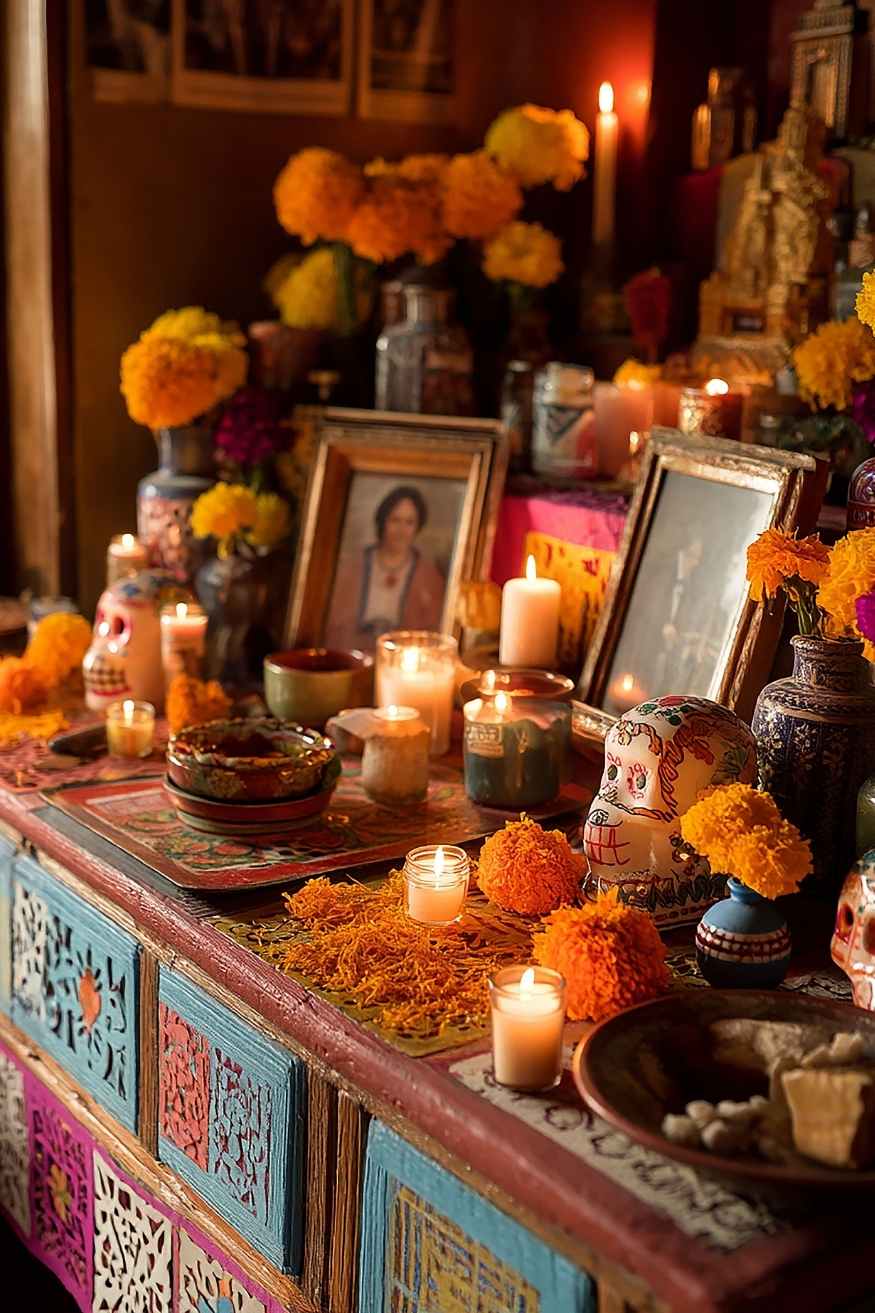
The Beginner’s Guide to Creating an Altar at Home
|
|
Time to read 8 min
Creating an altar at home is less about meeting the unending pinterest “aesthetic witchcore” and more about consistent spiritual practice. Think of it as a charging dock for your energy: a designated place where intention, attention, and action meet. Beginners don’t need elaborate tools either, what matters is clarity of purpose, daily touchpoints, and a setup that fits your life.
Table of Content
What an Altar Actually Is (and Isn’t)
An altar is a dedicated surface that represents your relationship with the sacred, however you define it. It can be devotional, meditative, ancestral, elemental, or a simple place to ground and reset.
It’s not a museum display; it’s a working station. If it never gets used, it’s décor. If it anchors your breath, your boundaries, and your goals, it’s an altar.
Altars have existed in nearly every spiritual tradition throughout history: from the household lararium in ancient Rome to ancestor tables in Asia, to Celtic hearth shrines and indigenous medicine bundles. What these all share is the understanding that space itself can become a conduit for spiritual connection.

Types of Altars
Before you begin assembling your altar, consider what type you’re creating. What will its purpose or energy by? Who or what are you working with? Here are some of the most common altar types:
Devotional Altar – Dedicated to a deity, goddess, or spiritual entity. Often includes statues, candles, incense, and offerings that honor that specific presence.
Ancestor Altar – A space to honor and communicate with ancestors. Common elements include photographs, heirlooms, candles, and food offerings.
Elemental Altar – Focused on working with the classical elements (earth, air, fire, water, and sometimes spirit). Used in many magical and witchcraft traditions.
Seasonal/Wheel of the Year Altar – Reflects the sabbats and changing cycles of nature. Often rebuilt for each solstice, equinox, or cross-quarter holiday. (Download our FREE Wheel of the year Workbook)
Manifestation or Intention Altar – Built around a specific goal, affirmation, or desire (e.g., love, protection, abundance, healing).
Daily Practice Altar – A general altar for daily meditation, energy hygiene, card pulls, or spiritual centering.

Must Have Products for your Altar:
Selecting for your Altar
Choose a Purpose Before You Choose Objects
Before shopping for anything, decide on a single, primary intention for your first altar: calm, clarity, protection, self-love, or ancestor connection are common starters. This gives you clean guardrails for what belongs on the altar and what doesn’t. If an item doesn’t serve your stated purpose, it’s clutter.
Where It Should Live (and Why Placement Matters)
Place your altar where you’ll actually interact with it, a bedroom corner, quiet shelf, or a compact tray you can store. If you’re pulled toward elemental symbolism, the east (air/new beginnings) works well for meditation; north (earth/stability) suits grounding; west (water/feeling) supports emotional work; south (fire/action) is ideal for motivation. No direction is “wrong,” but alignment boosts follow-through. Keep it reachable, safe, and private enough to relax your nervous system.
What to Put On It (Quality Over Quantity)
Start with one light source (candle or LED), one anchor (crystal, statue, photo), one cleansing method (incense, herbs, sound, or selenite), and one vessel (bowl/cup) to hold offerings or water. Four items are enough to begin, you can expand when your practice expands. Every object should “earn” its space by helping you focus, regulate, or act.
Starter Setup (your minimalist checklist)
Light: tea light, pillar, or flameless candle
Anchor: a single crystal (e.g., amethyst for clarity) or meaningful photo
Cleanser: incense, sound (bell), or selenite bar
Vessel: small bowl/chalice for water, herbs, or written intentions
(Add only when needed: journal + pen, tarot deck, seasonal flower, or a small cloth.)

Rituals That Build Momentum (Do Less, Repeat More)
Beginners often try to do everything and end up doing nothing. Instead, create a micro-ritual you can repeat daily in under three minutes. Example: light → breathe → speak one sentence of intention → close. On fuller days, expand into journaling, a single tarot pull, or a five-minute meditation. Consistency charges the space; inconsistency drains it.
How to Align Tools With Your Intention
-
For calm: soft light, lavender or mugwort, amazonite / lepidolite, bowl of water.
For clarity: clean lines, amethyst / sodalite, bell or chime, single index card with the day’s question.
For protection: sturdy candle, black tourmaline / obsidian, rosemary, boundary affirmation.
For self-love: rose quartz, rose petals, mirror for loving-kindness statements.
For ancestor work: a photo, glass of water, white candle, a small offering (bread, coffee, a coin).
Tip: choose one crystal and one plant ally per intention. Fewer variables = clearer signals.
Energy Hygiene: Cleanse, Refresh, Retire
Treat altar care like brushing your teeth. Quick cleanse weekly (smoke, sound, or intention sweep). Refresh monthly at the new or full moon: remove wilted offerings, wipe surfaces with a few drops of rosemary or rose in water, rewrite intentions. Retire anything that feels “tired”.
Choosing a Location for Your Altar
Location matters, not because of superstition, but because of energy flow. You want to place your altar where you can interact with it consistently and where it won't become cluttered or ignored. Some things to consider:
Privacy: Choose a spot where you feel safe, undistracted, and uninhibited. If you share space with others, a bedroom corner or cabinet altar may be ideal. If you feel drawn, inviting your family to create an altar with you has its perks!
Direction: Some traditions orient altars to the east (for air and sunrise), while others face north (for earth and stability). Choose a direction that aligns with your path or purpose.
Energetic Flow: Avoid areas near high traffic, chaotic energy, or electronic overload. If you must use a busy space, cleanse the area regularly.
Accessibility: Make sure it’s easy to reach. Your altar should invite daily interaction, not feel like a chore.
Common Mistakes (and quick fixes)
Too much stuff: if it doesn’t serve the purpose, remove it.
Inconsistent use: build a 2–3 minute daily ritual; set a phone reminder.
Unsafe flame: use a stable holder, keep away from curtains, or switch to LED.
Copy-pasting tradition: personalize! Use symbols and words that actually move you.
Outdoor dust-collectors: if it’s always messy, relocate or use a covered tray/box altar.

Cultural Respect, Ethics & Safety
Be discerning with sacred materials like White Sage and Palo Santo. (Download our free guide here) Use sustainably sourced herbs, skip endangered plants, and avoid closed-practice rituals you are unfamiliar with. Shopping at big box stores like 5 below or Walmart may save you a dollar or two, but more often than not you are paying a higher price in the end. They may be hopping on the spiritual train, but it isn't in our best interest or in the best interest of the products they are trying to sell.
When using flame, it can become more unpredictable than your usual contained fire when used in ritual work. Follow fire safety (stable base, ventilation, never leave unattended).

Making It Yours (and Keeping It Alive)
Your altar should change as you change. Set a cadence—new moon, sabbat, or the first Sunday of the month—to review your intention, then edit the objects to match the work you’re actually doing: replace a calm-focused stone with a courage stone, swap spring flowers for autumn herbs, trade a wish paper for a written boundary. Retire items with respect (thank them, cleanse with smoke or sound, and store in a dedicated box) and add one, deliberate new element so the space feels alive rather than crowded. Document the evolution: take a photo and jot two lines in a journal about what shifted and why; over time, this becomes a practical record of your inner work, not just a memory. If you fall out of rhythm, return without guilt, light a candle, name one intention, breathe for three cycles; that’s enough to restart.
Perfectionism stalls practice; consistent, honest tending is what keeps an altar powerful.
How to set up an altar
Key Takeaways
-
Start with one clear intention (calm, clarity, protection, etc.).
-
Place it where you’ll use it (quiet, reachable, low-stress spot).
-
Begin minimalist: light source, anchor item, cleanser, vessel.
-
Build a 2–3 minute micro-ritual you can repeat daily.
-
Align tools to purpose (one crystal + one herb per intention).
-
Cleanse weekly, refresh monthly; retire items with respect.
-
Adjust with seasons & life changes—evolution is the practice.
-
Personal > aesthetic—use symbols that actually move you.
-
Be safe & ethical (fire safety, sustainable herbs, cultural respect).
-
Document changes (quick photo + two-line journal).
Why This Matters:
-
Stops overwhelm, makes the altar immediately usable.
-
Increases consistency, so the space actually gets charged.
-
Prevents clutter, keeps focus tight and energy clear.
-
Builds momentum, tiny daily reps > occasional big rituals.
-
Strengthens signals, fewer variables = clearer outcomes.
-
Keeps energy hygienic, supports steady results over time.
-
Tracks growth, mirrors your real inner work, not a static shrine.
-
Improves resonance, boosts emotional regulation and buy-in.
-
Avoids harm & appropriation, aligns practice with values.
-
Creates a record, turning your altar into a living workbook.
This beginner’s guide shows you how to create a purpose-driven altar that fits your life, not just your aesthetic. You’ll learn what an altar really is (a working station for intention), how to choose a clear purpose before choosing objects, and where to place it so you’ll actually use it. The setup is minimalist and effective with options to align tools to goals like calm, clarity, protection, self-love, or ancestor work. You’ll get a simple 2–3 minute micro-ritual to build consistency, guidance on energy hygiene (weekly cleanse, monthly refresh), and ethical notes on materials and safety. The guide closes with a practical approach to evolving your altar over time and documenting changes so your space becomes a living record of your inner work.
Frequently Asked Questions
How often should I do a ritual?
Consistency is more powerful than intensity. A simple ritual done weekly, or even daily, will have more impact than an elaborate one you never repeat. Trust your body’s rhythm and adapt accordingly.
What if I don’t have a lot of time?
You don’t need a full moon or a day off. Most of the practices shared here take under five minutes. Micro rituals like breathwork, touch, or intention setting are nervous system gold.
Can I modify the steps to fit my needs or beliefs?
Absolutely. These practices are a framework, not a rulebook. Adapt the language, tools, or timing to fit your spiritual path or energetic preferences. Your intuition is your best guide.
Is this safe if I’m new to energy work or sensitive practices?
Yes. These rituals are gentle and designed with energetic sensitivity in mind. If anything feels too intense, pause. Come back when you're grounded. Your nervous system knows your limits, and honoring that is part of the work.







